‘Then We Entered a House of Glass, and in it was a Garden.’
An Account of the Emir of Katsina’s Visit to Kew Gardens
Jannis Kostelnik
The Miscellaneous Collection Reports (MCR) in the Library & Archives of the Royal Botanic Gardens in Kew, west of London, consist of over 770 volumes with thousands of folios, organised in scrapbooks, holding almost every kind of archival document imaginable: handwritten notes, drawings, maps, newspaper cut-outs and typewritten or manuscript letters from all over the world. Thus, the MCR provides – in the archive’s own words – ‘an essential resource for exploring the central role of Kew in the colonial and global networks of economic botany and scientific activity, 1850–1928’. Curiously, among all these documents, a single-leaf letter of only 13 lines immediately caught the present author’s attention. What is it that makes this document (fol. 44 in the Scrapbook MCR/10/7/9) special? Quite simply, it is testimony to the unlikely association of two very different botanic traditions, enshrined in an extraordinary written artefact.
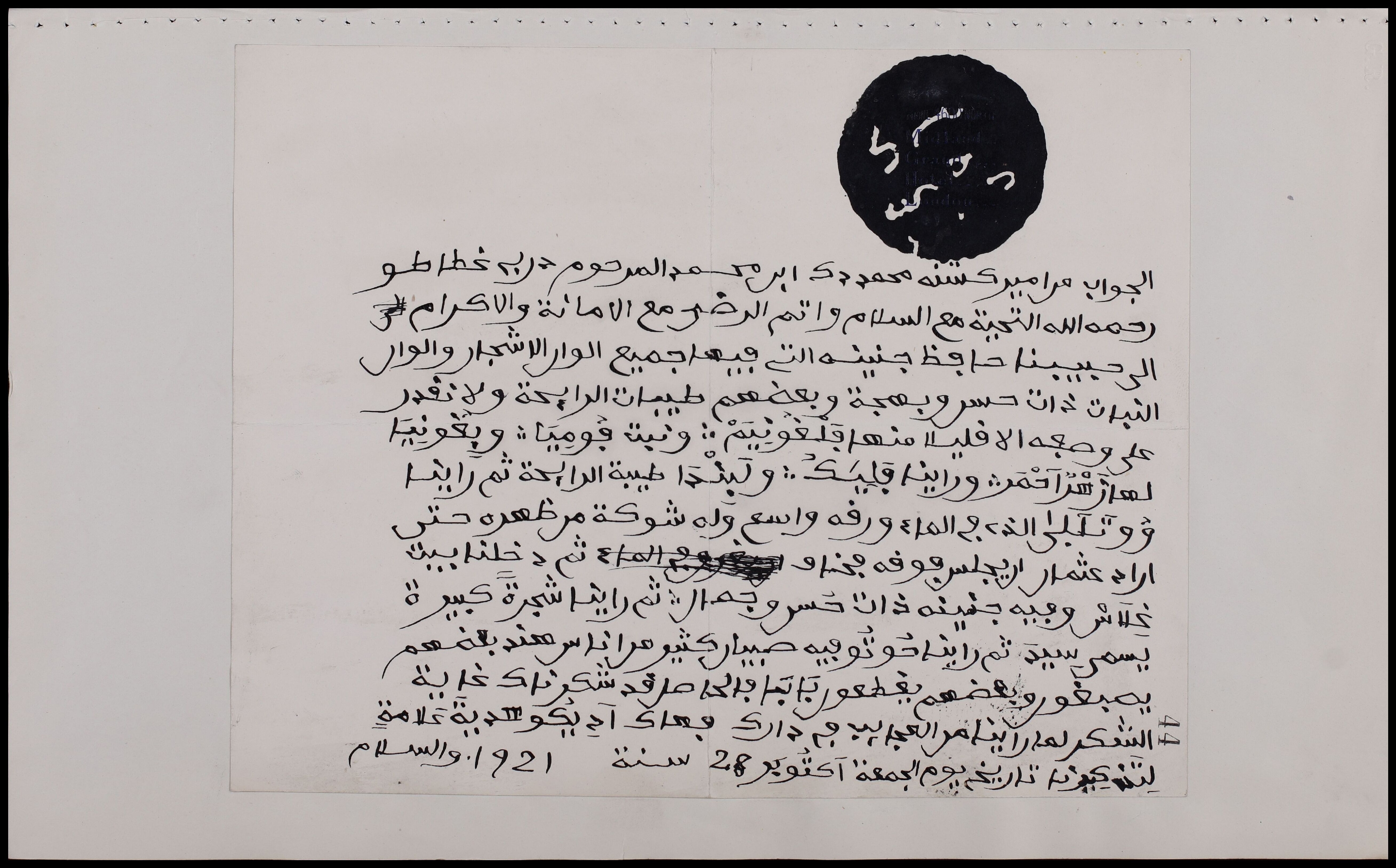
MCR/10/7/9 is an unassuming, leather-bound scrapbook containing 178 numbered folios, entitled ‘Nigeria. Misc. 1915–27’. In it, among typewritten reports from colonial institutions like the Agricultural Department in Ibadan, Nigeria or the Royal Botanic Garden’s branch office in Sibpur, India, a handwritten letter can be found, stamped ‘44’ (see Fig. 1). Its format (225 × 175 mm) is somewhat smaller than the typewritten correspondence following it, and it is thus glued to a larger piece of paper to fit in the scrapbook’s larger format. A closer look reveals a vertical fold in the middle. Apparently, the piece of paper was originally prepared as stationery, to be used as a folding card. However, the writer has disregarded the fold and used it like an unfolded sheet of paper, writing on only one side of it. The document contains 13 lines of text in total, written in a clearly legible Arabic hand. A number of non-Arabic terms are vocalised, meaning that vowels are indicated with the help of diacritics, and, as in most West African manuscripts, there is relatively little punctuation, except for a triple dot <∴> to mark enumerations of vocalised non-Arabic terms.
Prominently placed above the first line is a dark black circular stamp, about 5 cm in diameter, and with uneven edges. As can be gathered from traces visible within the seal, it is covering a printed letterhead. In the last line of the letter, a date is recognizable, written in Hindu-Arabic numerals (i.e. those commonly used in Europe) and Arabic letters:
yawm al-ǧumʿa ʾaktūbar 28 sana 1921
Friday, 28 October [of the] year 1921
In contrast to a letter written by a European – where the sender’s name would be expected either in the letterhead or in the final line (where, however, in this case, the date is found) – the sender reveals himself in the first line, which is almost fully occupied by his names and title. The line is completely unvocalised and reads:
al-ǧawāb min ʾamīr Katsina Muḥammad Dikku b. Muḥammad al-marḥūm Durbi Ġiṭāṭū
‘The reply by the Emir of Katsina, Muhammadu Dikko, son of the late Muhammadu Durɓi Giɗaɗo.’
Thus, the sender of the letter is revealed to be Muhammadu Dikko (1865–1944), the 47th Emir of Katsina, one of the seven traditional kingdoms (Hausa bakwai) of Northern Nigeria. After having inherited his father Muhammadu Giɗaɗo’s title of durɓi (king-maker), Muhammadu Dikko became a close advisor to the then ruling Emir and, at the same time, built good relations with the British colonial power, which, in an era of political instability, later favoured his ascent to the throne of Katsina, which he held from 1906–1944. Unfortunately, we are not in a position to say with any certainty that the letter was written by the Emir himself. On the one hand, we know that the Emir was accompanied by his personal secretary, who assisted him in keeping a diary of his travels, which is now in the National Archives Kaduna, Nigeria; on the other hand, the present writer could not compare the letter with the diary in order to determine whether the handwriting is the same.
The letter, which is addressed to ‘our cherished custodian of the garden’, i.e. Sir David Prain (1857–1944), Director of Royal Botanic Gardens Kew, from 1905–1922, describes, in a very positive tone, the Emir’s visit to the Gardens. The Emir’s letter describes flowering plants such as pelargonium or begonia as well as trees such as cedars; he also mentions the Giant Waterlilies (Victoria amazonica) – which is still one of Kew’s main attractions – and describes his awe at seeing a garden within a house of glass (almost certainly the impressive Temperate House). He also notes that he was shown pictures of Indian men cutting and dyeing indigo, probably within the Economic Botany department of the gardens. At times, the tone of the letter becomes somewhat strange, even tongue in cheek: In line 8 we find a crossed-out section retelling the story of the Emir’s seeing the giant waterlilies in Kew, then wanting to sit on them but finally aborting his quest for fear he might drown. One can vividly imagine the discussions that might have taken place before this section – no doubt embarrassing for the 48th Emir of Katsina who, at the time of the visit, was a 15-year-old prince – was crossed out in the letter.
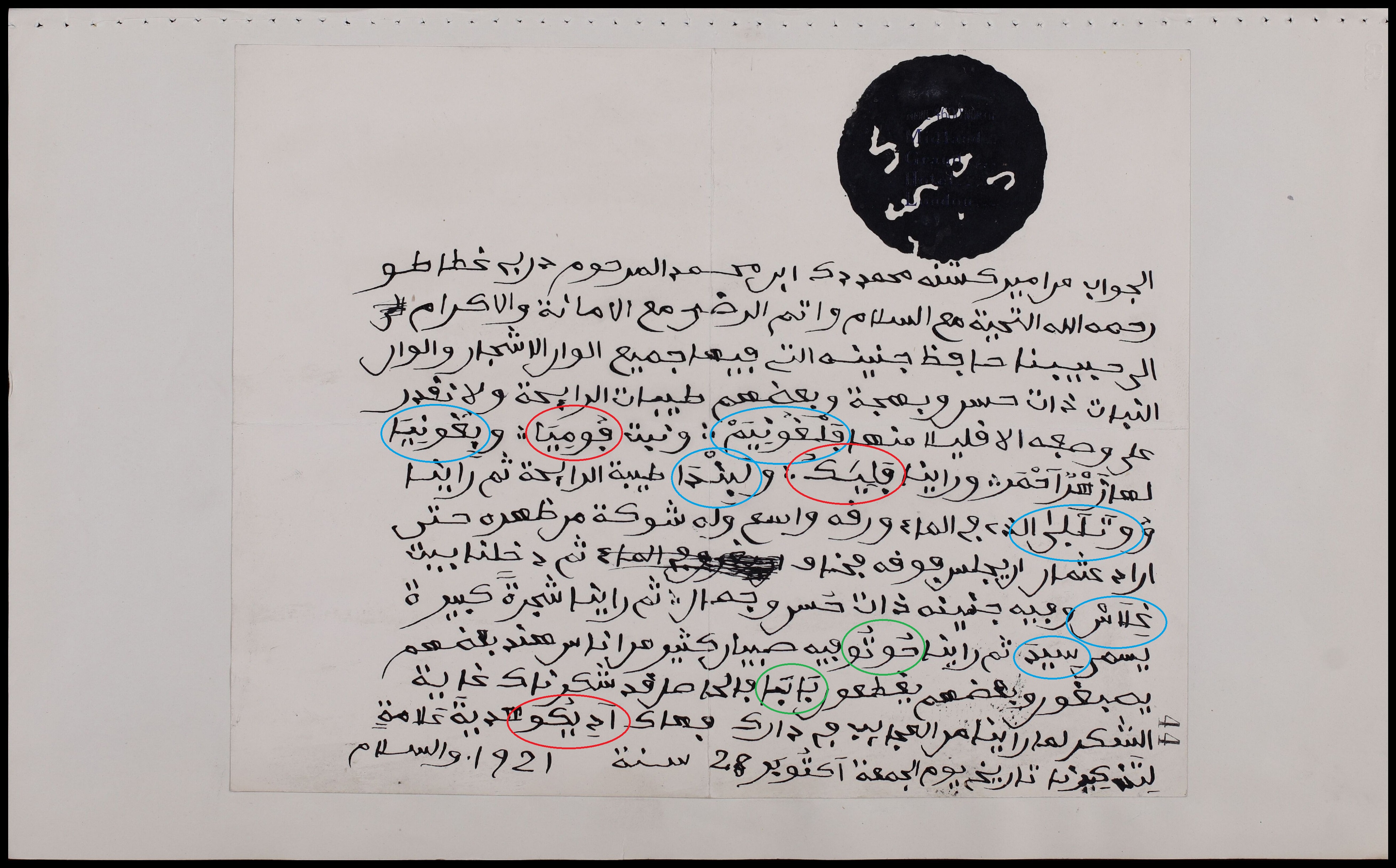
The most striking element of the letter is its choice of language: While the main body of the text is in Arabic, a number of non-Arabic terms are interspersed, 11 in total (see Fig. 2). Surprisingly, only two of these non-Arabic terms are written in the Emir’s native language, Hausa. Hausa is an Afroasiatic language spoken in Northern Nigeria, Niger, and Northern Ghana by more than 50 million native speakers. These Hausa terms are marked in green in Fig. 2. The terms in question are ḥūtū (hoto, ‘photo’, line 10) and bābā (baba, ‘indigo’, l. 11). The larger part of the foreign terms are, surprisingly, in English, highlighted in blue in the photo above. Most of the English terms are for plants or trees: falġūniyam (‘pelargonium’, l. 5), biġūniyā (‘begonia’, l. 5), labinda (‘lavender’, l. 6) and sīda (‘cedar’, l. 10). These terms were probably taken from English because the scribe did not know these plants and trees. The orthographic peculiarities of the English terms written in Arabic can be explained mostly by the constraints of the Arabic alphabet and by peculiarities of Hausa phonology, which does not distinguish between ‘f’ and ‘p’ sounds and lacks the ‘v’ sound in ‘lavender’. Additionally, the term ‘glasshouse’ is expressed by the Arabic-English compound term bayt ġilās (‘a house of glass’, l. 9). This is a fringe case, as the Hausa word for ‘glass’ is gilashi/gilasi, a loan from English. The vocalisation in the letter however is testimony to a mixed form. Similarly, the Hausa word hoto, mentioned above, is a loan from English photo. Finally, three terms – those marked red in the photo (Fig 2) – could not be identified at all: Fūmiyā (l. 5) and faliyāku (l. 6) are probably also terms for plants. Unfortunately, it was not possible to determine the meaning of the third word, ʾadiyukū (l. 12), which is commonly/often used in the context of gift-giving: fa-hāka ʾadiyukū hadiyata ʿalāmatin li-taḏkīrinā (‘and take ʾadiyuku as gift and symbol of our remembrance’). Perhaps this is also an English word, with the indefinite article a fused to it.
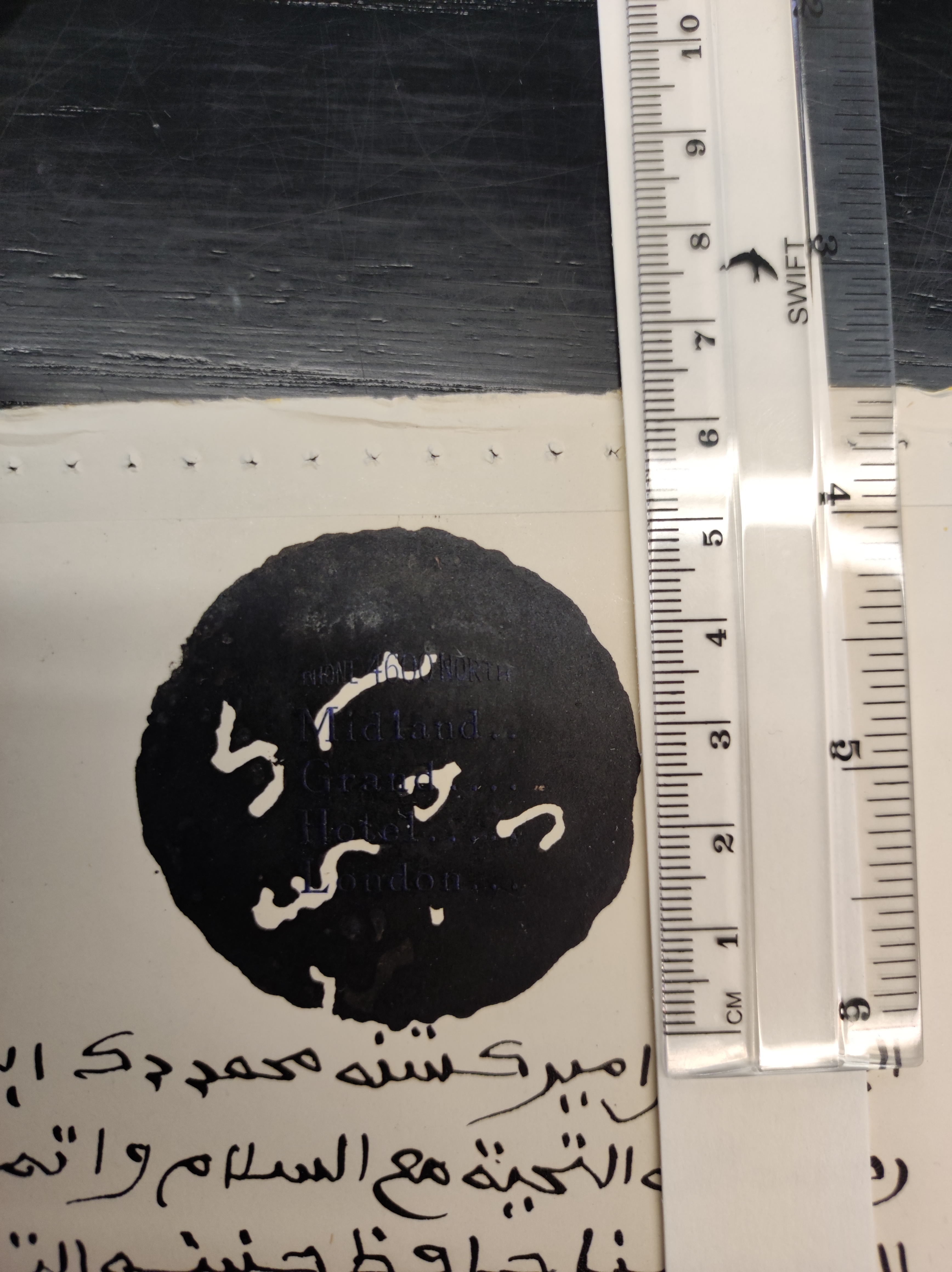
Having described the content, we may now turn our attention to the seal, which is a further interesting feature of this written artefact. Although only fragments of some of the written letters can be recognized, a close examination of the seal reveals a printed letterhead below it. Although the letterhead is almost illegible on fol. 44, a comparison with fol. 43 (cf. Figs. 3 & 4) shows that both sheets come from the same source, namely the Midland Grand Hotel – today’s St. Pancras Renaissance Hotel, adjacent to St. Pancras International (cf. Fig. 5).
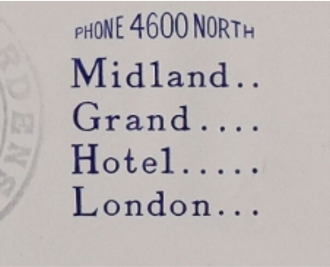
At this point the content of the letter, the identity of its sender and its origins are clear. However, a major question remains: How do we contextualize this written artefact.
Muhammadu Dikko visited London on several occasions, the first two being in the summer and autumn of 1921, framing the Emir’s pilgrimage to Mecca. The letterhead evidently indicates that the Emir stayed in the Midland Grand Hotel. Following his every move, the press also accompanied his visit to Kew on 12 July, later reporting that the Emir marvelled at English roses and intended to take some home with him ‘to “make the desert bloom like a rose”’. While this might have been patriotic wishful thinking on the part of the journalists, the archival context – another letter found on the preceding folio of the same scrapbook – makes it clear that the Emir indeed took some plants home.
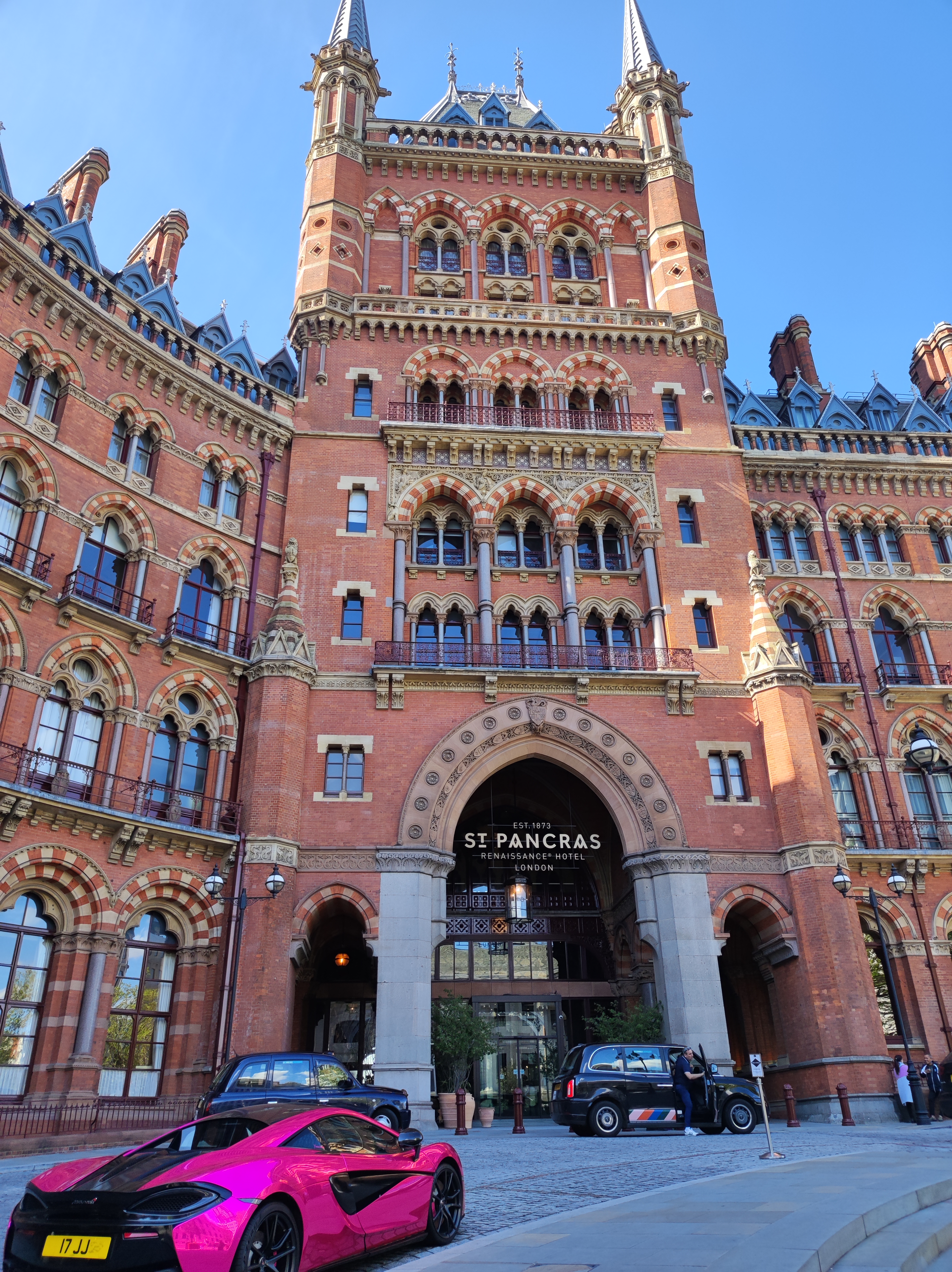
The letter just mentioned (found in fol. 43 of MCR/10/7/9) was written by a high-ranking colonial officer in Northern Nigeria, and provides us with a list of plants that RBG Kew gave Dikko and states that ‘the Emir [was] simply delighted’. Digging deeper into the Kew Archives, we find, in the Goods Outwards Book 1920-24, fol. 85 an added handwritten note stating that further plants were sent to the Emir in December of 1921. Gifts of plants continued, not only from Kew to the Emir, but in both directions. This is confirmed by both the Goods Inwards Book 1916-27, fol. 167, and the Goods Outwards Book 1920-24, fol. 121, which record parcels of plant species sent back and forth between Kew and Katsina.
While the Emir’s 1921 travels have been contextualized by various authors, the letter has apparently not been found or considered by his biographers. Thus, it serves as another part of the mosaic, helping to reconstruct Dikko’s first journey to Europe. Moreover, it sheds light on an aspect of his relations with the Empire that has, so far, been overlooked, namely, the botanical exchange with the ‘Gardens of Empire’, as the Royal Botanic Gardens, – given their importance in economic botany during the time of the British Empire – became known. Furthermore, this letter underlines the wealth of information that can be found in a seemingly inconspicuous, single-leaf manuscript, and underlines the importance of exploring the archival context in which such manuscripts are found.
References
Fuglestad, Finn (1978), ‘A Reconsideration of Hausa History before the Jihad’, Journal of African History, 19/3: 319−339.
Heaton, Matthew W. (2023), ‘Power, Patronage and Privilege: The 1921 Hajj of Muhammadu Dikko, Emir of Katsina’, in Decolonising the Hajj: The Pilgrimage from Nigeria to Mecca under Empire and Independence, Manchester: Manchester University Press, 66−92.
Kagara, Muhammadu Bello (1951) [1981], Sarkin Katsina Alhaji Muhammad Dikko, C.B.E, 1865−1944, Zaria: Gaskiya Corporation.
Ochonu, Moses E. (2022), ‘Emir Dikko’s Metropolitan Adventures’, in Emirs in London: Subaltern Travel and Nigeria’s Modernity, Bloomington: Indiana University Press, 91−132.
McCracken, Donal P. (1997), Gardens of Empire: Botanical Institutions of the Victorian British Empire, London: Leicester University Press.
Moore, Rowan (2011), ‘St Pancras Renaissance Hotel: The Rebirth of a Gothic Masterpiece’, The Guardian, 13 February 2011. https://www.theguardian.com/artanddesign/2011/feb/13/midland-grand-hotel-st-pancras.
Description
Location: Miscellaneous Collection Reports; Library & Archives of the Royal Botanic Gardens, Kew
Shelfmark: MCR/10/7/9, fol. 44
Date: 28 October 1921
Material: stationery (paper folding card) with printed letterhead
Size: 225 × 175 mm, glued to a larger piece of paper within a scrapbook (205 × 320 mm)
Origin: Midland Grand Hotel, London
Acknowledgements
I am greatly indebted to the Royal Botanic Gardens’ Library & Archives for making it possible to see and photograph the hard copy of the digitized letter and to Wiley Digital Archives for providing me with the license to publish the digital version of the letter.
Reference Note
Jannis Kostelnik, ‘Then We Entered a House of Glass, and in it was a Garden.’ An Account of the Emir of Katsina’s Visit to Kew Gardens. In Leah Mascia, Thies Staack (eds): Artefact of the Month No. 33, CSMC, Hamburg.
